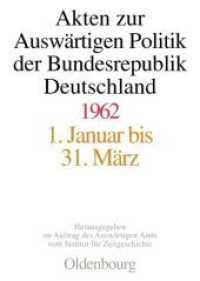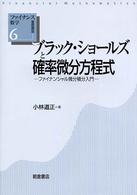- ホーム
- > 洋書
- > ドイツ書
- > Mathematics, Sciences & Technology
- > Chemistry
Full Description
An essential resource for circular economy engineering as a business sustainability solution and risk mitigation measure
In Applied Circular Economy Engineering: Technologies and Business Solutions to Implement Circularity, a team of distinguished researchers delivers an up-to-date discussion of the implementation of circular economy concepts in industrial practice. It examines a comprehensive range of solutions and ideas from engineering and business research from the perspective of the European Circular Economy Package.
The book explores the most relevant material and product flows, including metals, polymers, and food, as well as common product lifecycle steps, like product design, material extraction, and recycling. Applied Circular Economy Engineering explains the most effective applied practices, business considerations, and forward-looking solutions to frequently experienced business problems.
Readers will also find:
A thorough introduction to how circular economy considerations influence process design, product design, energy, and waste management
Real-world case studies of circular design and processes
Practical discussions of a wide variety of industries adopting circular economy principles, including medical devices and food
Complete treatments of circular economy implementation and challenges, including business circularity maturity assessments and transition plans
Perfect for chemical and process engineers, Applied Circular Economy Engineering: Technologies and Business Solutions to Implement Circularity will also benefit business economists, product planners, and anyone else involved in the engineering and development of circular products or processes.
Contents
Preface xiii
About the Companion Website xv
Part I Introduction 1
1 Challenges and Perspectives of Applying Circular Economy in Business and Engineering 3
Juliano Araujo, Henning Hinderer, Tobias Viere, Jörg Woidasky
1.1 Introduction 3
1.2 Strategic Approach for CE Implementation 4
1.3 Comprehensive Evaluation of Business Circularity Readiness 7
1.4 Overview of Current Progress in Business Circularity 9
1.5 Innovation as a Key Driver for Business Circularity 10
1.6 Conclusion and Structure of This Book 13
Part II Materials (Selection, Properties) 19
2 Aluminum Alloys, Recycling, and the Circular Economy 21
Robert Sanders, Wilhelm Kiefer
2.1 Introduction: The Importance of Recycling for the Aluminum Industry 21
2.2 Current State of the Circular Economy for Aluminum 22
2.3 Innovations in Scrap Processing Technologies 36
2.4 Summary and Conclusion 40
3 Circular Economy of Polymers -- Its Current State in Germany and Beyond 43
Maximilian Auer, Jannick Schmidt, Jörg Woidasky
3.1 Introduction 43
3.2 State of the Art of Plastic Categories and Applications 44
3.3 Polymer Production in Europe and Germany 46
3.4 Polymer Waste in Europe and Germany 48
3.5 Lightweight Packaging Waste Collection Systems 48
3.6 Lightweight Packaging Sorting in Germany 50
3.7 Plastic Waste Recycling 51
3.8 Conclusion 53
4 Implementing Circular Value Creation in the Construction Sector 63
Franziska Struck, Celestin Stretz, Gotthard Walter, Dirk Klöpper, Sabine Flamme
4.1 Background 63
4.2 Challenges for the Implementation of Circular Value Creation in the Construction Sector 64
4.3 Approaches for Increasing Circular Value Creation in the Construction Sector 65
4.4 Outlook/Perspectives 75
Part III Products (Design, Servitization) 79
5 Circular Process Implementation for Electric Drives -- Experiences and Examples 81
Jürgen Miller
5.1 Introduction 81
5.2 Environmentally Friendly Product Design: New Challenges 85
5.3 Closing the Loop -- Circular Return 90
5.4 Disassembly, Treatment, and Reuse 92
5.5 Industrial Examples 92
5.6 Conclusion and Outlook 94
6 Circularity in the Healthcare Industry 97
Marcel Kern, Jörg Woidasky
6.1 Current Challenges in the Healthcare Sector 97
6.2 Handling Clinical Waste 98
6.3 Waste Production in Hospitals 100
6.4 Medical Devices 101
6.5 Circular Economy in Medical Technology 104
6.6 Conclusion 106
7 Circular Economy Indicators for Product Design -- Calculation and Applicability 111
Paula Kuhn, Juliano Bezerra de Araujo, Annika Pruhs, Anina Kusch, Frank Bertagnolli, Tobias Viere
7.1 Introduction 111
7.2 Methodology 114
7.3 Results and Discussion 117
7.4 Conclusion and Perspectives 126
8 Makigami of an Industrial Product Development Process: Use of a Lean Methodology to Integrate Sustainable and Circular Product Design 133
Annika Pruhs, Anina Kusch, Frank Bertagnolli, Tobias Viere, Jörg Woidasky
8.1 Introduction 133
8.2 Analysis and Visualization Through the Makigami Methodology 134
8.3 Product Development Process in Practice 134
8.4 Current State: Recording of the PDP 135
8.5 Target State: Integration of the EDA into the PDP 137
8.6 Implementation of a Circularity-oriented PDP 141
8.7 Conclusion 141
Part IV Technology (Production and Business Processes) 145
9 Single-stage Sorting and Marker Technology for a Circular Economy of Polymers 147
Guojun Gao, Dirk Wacker, Beate Kummer, Robin Just, Reiner Just, Markus Reisacher, Christof Strohhoefer, Jochen Moesslein
9.1 Introduction 147
9.2 Problems with Existing Conventional Sorting Technology 150
9.3 Sort4Circle® Innovations Compared to the Competition 153
9.4 Conclusion 156
10 Embracing Entomophagy: Insects as Catalysts for Sustainable Circular Economies 159
Gia Tien Ngo
10.1 Introduction 159
10.2 Back to the Roots Can Also Drive Innovations 159
10.3 Advantages of Insects as Food and Feed 161
10.4 Case Study Alpha-protein 165
10.5 Industrial Automation as the Key to Sustainability 167
10.6 The Promising Future of the Insect Industry: A Beacon of Sustainability 168
11 Digital Technologies for Enabling and Engineering the Circular Economy 171
Heiko Thimm
11.1 Introduction 171
11.2 CE Principles in the Context of Collaborative Business and the Internet Evolution 172
11.3 Transition Toward the CE -- ICT-specific Barriers and Challenges 175
11.4 The Concept of the Circular Economy Digital Machine Room 177
11.5 Use Cases 183
11.6 Conclusion 188
Part V Organization (Management, Business Models) 197
12 Finding Ideas for Sustainability-oriented Innovations: Using Circular Business Models for Innovation 199
Claus Lang-Koetz, Philipp Wichert, Leon Deterding
12.1 Introduction 199
12.2 Business Models and CE 202
12.3 Sustainability-oriented Innovation Management 206
12.4 Creative Search for New Ideas 207
12.5 Practical Approach on How to Use CBMs in Innovation Management 208
12.6 Conclusion and Outlook 212
13 Circular Economy Business Models and Ecodesign Approaches in Practice -- A Case Study Literature Review 219
Liz Fohrenkamm, Juliano de Araujo, Tobias Viere
13.1 Introduction 219
13.2 Methods 220
13.3 Results 224
13.4 Discussion 230
13.5 Conclusion 232
14 The IRMa Approach -- Integrative Resource Efficiency Management in Small and Medium-sized Enterprises 235
Alexandra Vogt, Ingela Tietze, Philipp Preiss, Claus Lang-Koetz, Heidi Hottenroth
14.1 Introduction 235
14.2 State of the Art: Conceptual Frameworks for SMEs in Resource Efficiency and Circular Economy 237
14.3 Methodology 239
14.4 IRMa Approach 239
14.5 Application 246
14.6 Conclusion and Outlook 247
Acknowledgement 248
Part VI Contextualization of Circular Economy Engineering 253
15 Cultural and Cross-Cultural Requirements of Circular Economy Engineering: Addressing Issues of Global Responsibility, Social Sustainability, and Ethics 255
Jasmin Mahadevan
15.1 Introduction 255
15.2 Essential Concepts 256
15.3 Three Properties of Culture and Ensuring Requirements 257
15.4 The Systemic Challenge of Culture and How to Address It 264
15.5 The Engineering Dimension of Culture and Its Implications 270
15.6 Towards an Interculturally Competent Circular Economy Engineering 273
15.7 Summary and Conclusion 274
About the Author 275
16 The Actual Goals and Limits of Circular Economy -- A Critical Perspective 277
Mario Schmidt
16.1 Introduction 277
16.2 Review of Common Premises 278
16.3 Circularity as an Overall Goal? 279
16.4 Lack of Proper Assessments and Indicators 281
16.5 Holistic Approaches Needed 282
16.6 Concluding Remarks 283
References 283
Index 287








